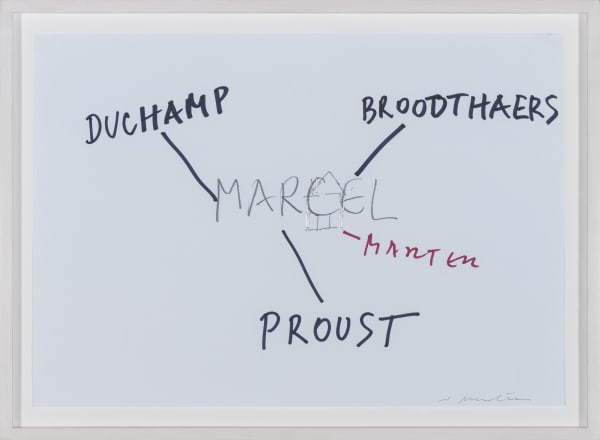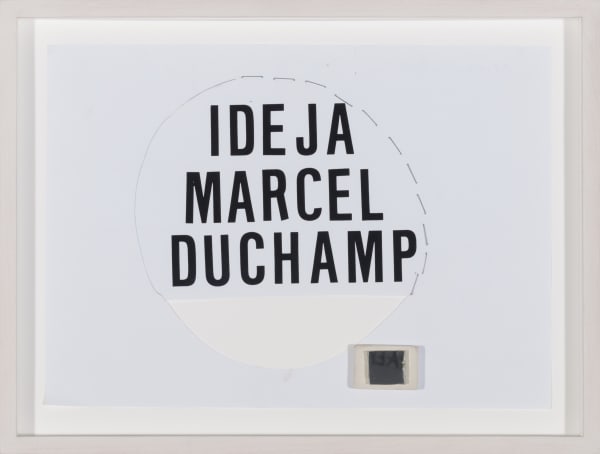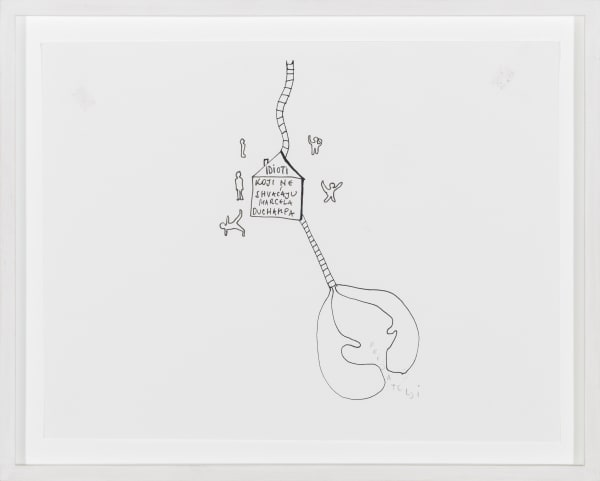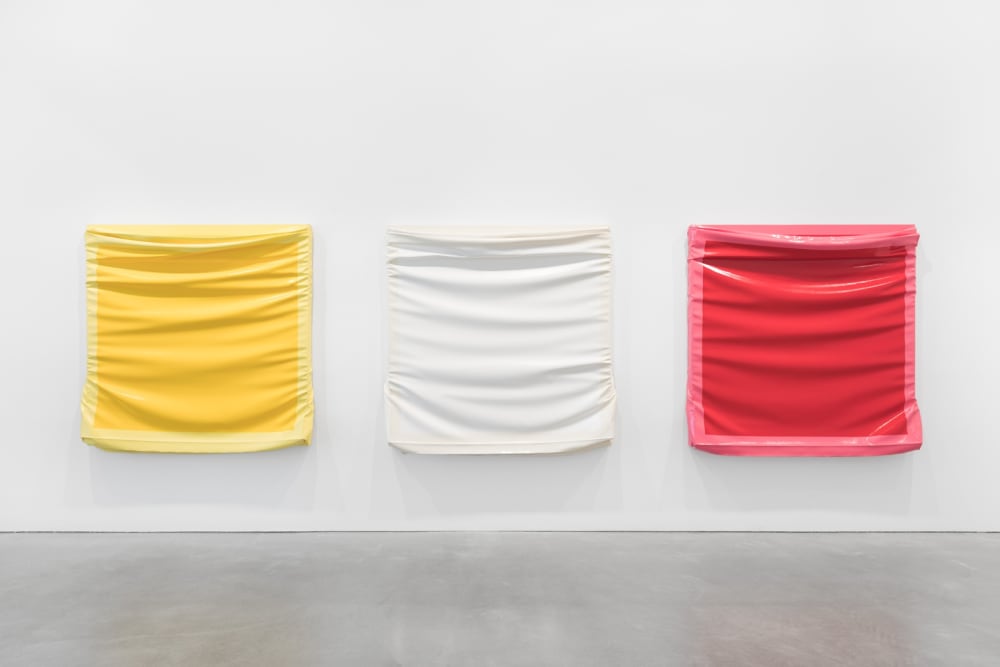Eighteen Exhibitions: Teil 10. Der Kubist Marcel Duchamp mag nicht malen: GROUP SHOW
-
介绍
Group exhibition with:
Athanasios Argianas, Wolfgang Betke, Ellen Blumenstein, Luis Camnitzer, Angela de la Cruz, Martin Dammann, Jochen Dehn, Friederike Feldmann, Ryan Gander, Young Hay, Bethan Huws, Michael Kunze, Vlado Martek, Ray K. Metzker, Karin Sander, Wilhelm Schürmann, David Schutter, Nedko Solakov, Lukas Töpfer, Raphaël ZarkaMichael Müller continues his extensive search for what art is or can be in the space of Galerie Thomas Schulte with the group exhibition, Der Kubist Marcel Duchamp mag nicht malen. Once again, this twelfth part of the exhibition cycle is based on Robert Musil‘s novel, The Man without Qualities, which takes place in the year 1913. 1913 is also the year, in which Duchamp created his first Ready-Made – and, thus, set a revolutionary milestone in art history, while receiving much critical acclaim for his early Cubist paintings at the time.
For his show, Michael Müller has invited 18 contemporary artists and culturally involved individuals, who have dealt with this historic moment in art and have largely created new works for the show: Take for example, Lukas Töpfer (*1988): The young art historian, who, for this show, appears for the first and, presumably, last time, as an artist, presents a copy of the drawing which Duchamp made to describe the damage to his work, The Large Glass (1915-1923). When making a miniature reproduction of the work, Duchamp insisted on copying every single crack, tear and scratch according to his sketch, because for him they had become part of the work and thus also part of the replica. Luis Camnitzer (*1937) replaces the traditional painting surface of linen with glass in his work Revelation. Subsequently, as though looking through a window, one’s gaze is directed at the canvas stretcher, the structure holding the wall-piece together. Karin Sander (*1957) also focuses on presentation and material references in her so-called Gebrauchsbilder or Patina Paintings. Sander attaches four customary, white, primed canvases with different dimensions to the outside windows of the gallery. The canvases are intended to gather traces in their predetermined positions. Similar to Camnitzer, Sander presents the canvas behind glass, making the stretcher visible and at the same time dissolving it.
What Camnitzer and Sander do on the wall, Raphaël Zarka (*1977) does in the third dimension. Massive, solid wooden wedges form into an arch, turning painting into an object (Prismatique (3)). The purple-blue canvas, detached from the stretcher, as though it were outgrowing its carrier, in Angela de la Cruz’s (*1965) work, Tight, tells of abstraction, shape, and vulnerability. As though one were peering into the head of the painter, Nedko Solakov (*1957) shows in his painting, Twelve Semi-Paintings Done in a Very Fast Way #10, the steps or phases in the development of a pictorial narrative, from the initial idea to completion – a kind of storyboard for the canvas, an abstract picturesque screenplay. Also the pieces by Ryan Gander (*1976) deal with the inception of works of art. On the backside of two circular pieces of acrylic glass, paint has been applied, making them appear as painter’s pallets, which have turned into paintings. Or are the pallets really just pallets and the paintings they have produced are somewhere else? (Please be patient – Eran Schaerf wrongly identifying my wet laundry as an artwork, Maastricht, January 2000; Please be patient – Wim Crouwel being explained to his wife who Ryan Gander is, Basel, Switzerland, 2009).
David Schutter (*1974), in his matt-grey oil painting, refers always to works by other artists. The Pennsylvania-born artist’s main interest is the painterly process, which he investigates as a scientist, studying the technicality and the metaphysical. In this case not the medium should be questioned, but the painted picture itself. Equally so, Wolfgang Betke (*1958), whose aluminum folding screen stands in the center of the exhibition space, with shapes and colors applied and removed on either side. Resolution, narration, and reflection are dealt with by this piece, functioning as a double-sided triptych. Michael Kunze (*1965) also represents a classic painterly position, who in the focus of his work, Ni sucre, ni mort d’ailleurs, displays Duchamp’s bottle rack as a fallen monument, which, once adorned with a bay wreath, now gently ascends into the air and suggests to fly away. The Welsh Bethan Huws (*1961), who in her oeuvre repeatedly deals with Marcel Duchamp, also brings the bottle rack into this exhibition. The delicate glass unicum dangles from the ceiling and turns the concept of Ready-Made ad absurdum. Vlado Martek (*1951) takes Duchamp literally in his series of works on paper. In 10% artist, for example, a photocopy of the flyer for the installation, Given: 1. The Waterfall, 2. The Illuminating Glass, which Duchamp worked on shortly before his death in 1968, is visible.
Generally, the elements water and gas were of great interest for Duchamp. Jochen Dehn, who was born in 1968 in Hamburg and lives in Paris, presents a construction, which, as a geyser, ejects water like a fountain in irregular intervals (Stokkur). The water is led through diverse canals, hoses, and receptacles and is finally, at the height of four meters, projected upward. The piece can be read as homage to Duchamp’s urinal, which he entitled La Fontaine. Athanasios Argianas’ (*1976) golden hat,Tapping Touching Tapping No Words No Words (brass hat vs 1), emits a brassy sound from within and once again draws reference to the year 1913, when Duchamp wrote musical notes on pieces of paper, placed them in a hat, and pulled them one after another, subsequently making the order into a random score.
Friederike Feldmann (*1962) also makes a distinct link to a work of Duchamp in her wall painting, ich weiß, du grün. She shows the negative image of a box, namely the so-called Green Box, which appeared in 1934 in an edition of 300 and contained diverse notes of the artist. Wilhelm Schürmann (*1946), who, as a collector and photographer, offers one of his own as well as two photographs by Ray K. Metzker (*1931) and Young Hay (*1963) to the exhibition, addresses in the black and white images the selective perception of creative individuals, who, when observing the rectangular area, reminiscent of painted over graffito, is reminded of the iconic Black Square by Kasimir Malewitsch. All three images are captured in daily life, which combine the photographic medium with painting.
Also Martin Dammann (*1965) uses a photograph in his work, M.D.. However, it is a found photograph. It depicts a man in profile, seated at a table, in a position, which is reminiscent of an image by Duchamp playing chess. The letters M and D are at the same time used as the title as well as the artist’s signature which, being also the initials of Duchamp, poses new questions of authorship and representation.
Michael Müller’s relentless analysis of the art scene and his endeavor to question and break schemes is quite possibly most obvious in Ellen Blumenstein’s (*1976) work. As the curator was asked to contribute to the show, she does so in form of a speech, which she personally gives every night at 6 pm and in which she asks questions about the nature of the work of a curator or its artistic and mercantile value
-
安装图示
-
作品
-
Inquire about works in Eighteen Exhibitions: Teil 10. Der Kubist Marcel Duchamp mag nicht malen

-
参展艺术家




































